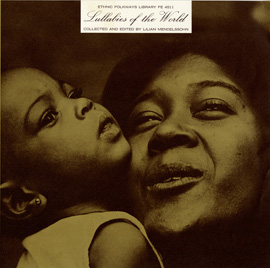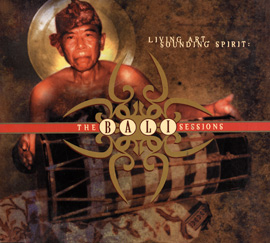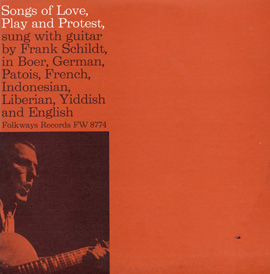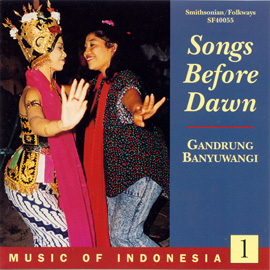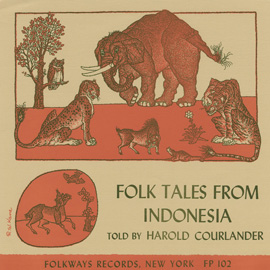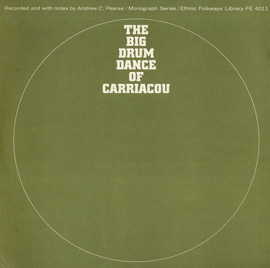Summary
Vocal music is a key expression in many cultures. It often ties an ancestral past (history, identity, ritual) to the present through story-telling, text, song, and dance. This unit focuses on a selection of vocal music from Indonesia and asks students to explore the ways in the vocal music expresses culture. In doing so, this unit focuses on an Indonesian lullaby, a Sikka work song, and Kecak vocal orchestra.
Suggested Grade Levels: 6-8, 9-12, and Tertiary
Country: Indonesia
Region: Flores, Bali
Culture Group: Indonesian, Balinese, Sikka-Atta Krowe Community
Genre: Lullabies, World Music
Instruments: Voice, Body Percussion
Language: Indonesian
Co-Curricular Areas: World Literature, Ethnomusicology
National Standards: 1, 2, 3, 4, 5, 6, 9
Prerequisites: None, however, a beginning understanding of basic music concepts including form, timbre, rhythm, melody, and harmony would be helpful.
Objectives:
- Listen to, analyze, and discuss a variety of story-telling songs from Indonesia.
- Learn, read notation, and perform a lullaby from Indonesia.
- Learn and play along with a “Lero” from Flores, Indonesia.
- Create a new song in the form of a “Lero”.
- Adapt and perform sections of a Kecak from Indonesia.
Material:
- Recording of “Hay ti moñ anacosa / O anané kéké (medley)” from Lullabies of the World.
- Recording of “Lero” from Music of Indonesia, Vol. 8: Vocal & Instrumental Music from East & Central Flores.
- Recording of “Kepandung Sita” from The Bali Sessions: Living Art, Sounding Spirit.
- Liner notes and additional materials available on the Smithsonian Folkways website.
- Audio technology to play recordings in the classroom.
- Technology to show images of maps, instruments, costumes, people, etc.
Lesson Segments:
- An Indonesian Lullaby (National Standards 1, 2, 5, 6, 9)
- A Work Song (National Standards 1, 2, 3, 4, 6, 7, 9)
- Kecak Vocal Orchestra (National Standard 1, 2, 5, 6, 9)
Lesson Segment 1: An Indonesian Lullaby

“Indonesia: Hay ti moñ anacosa / O anané kéké” (medley)”
from Lullabies of the World (1963) | FW04511
Procedure:
- Listen to “Hay ti moñ anacosa / O anané kéké (medley)” - focusing on the second song, “O anané kéké” (beginning at 1:48) - from Lullabies of the World
- Ask students to talk about the song. Some guided questions might include:
- What is it?
- Where does it come from?
- Is this a modern song or an old fashioned song?
- What does the voice sound like?
- Is the singer male or female?
- Is the singer young or old?
- Listen to the recording again as needed to illustrate elements of student’s answers.
- Show a map of Indonesia (From liner notes, others available on Google)
- Take time to note a brief history of the country, climate, commerce, food, religions, etc.
- Ask students to tap the rhythm they hear, as they listen to “O anané kéké” again.
- What kind of a song is this? (lullaby)
- What about this song makes it suitable for a lullaby? (soft and slow qualities)
- What lullabies do you remember as a child? Would you share them?
- Text Translation: Go to sleep. All my love is for you and I protect you in my arms.
- Review Indonesian text with the students:
Oyinani keke, moke mosaku,
Moriva keke ima tumo rugma lalo,
Ueane, ueane, ueane keke,
Tanima sia papa sanemo osie. - Sing “O anané kéké” with the recording.
- While singing, ask the students to find a complimentary motion to accompany their singing.
- If instruments are available, the melody could also be played on xylophones or recorders.
- Sing “O anané kéké” without the recording.
- Refer to the recording as needed to refresh the tune.
Extension:
- Comparing lullabies of other cultures or other elements of childhood would be an interesting activity.
- Indonesian folk tales are also available to listen to on the Smithsonian Folkways site. From here, students could be encouraged to write their own folk stories to share.
Assessment:
- Students will be able to perform “O anané kéké” by memory and without teacher assistance.
Lesson Segment 2. A Work Song
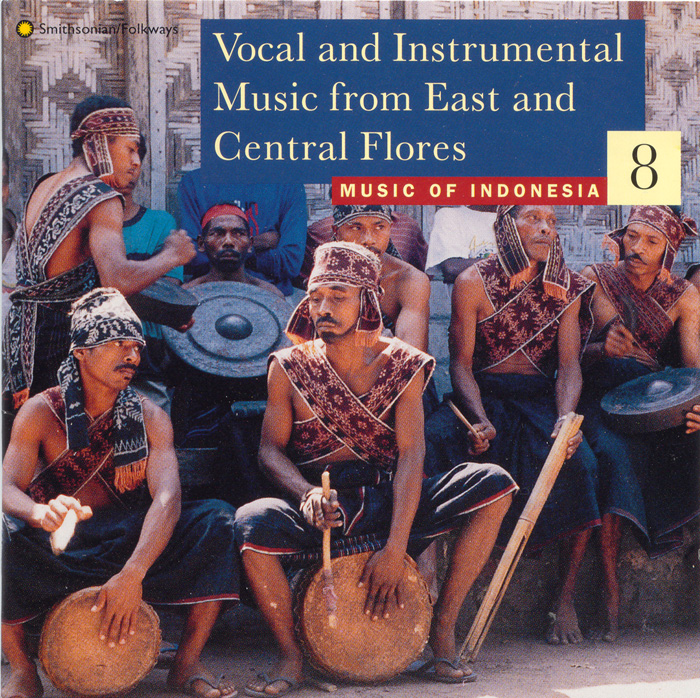
“Lero”
from Music of Indonesia, Vol. 8: Vocal and Instrumental Music from East and Central Flores (1995) | SFW40424
Procedure:
- Listen to “Lero” from Music of Indonesia, Vol. 8: Vocal & Instrumental Music from East & Central Flores
- Ask students to tap the beat that they are hearing while they are listening to the music.
- What sounds are they hearing? (voices, sticks) Teacher may want to play sections of this music again to highlight the answers that students offer.
- What kind of a song is this? (work song, festival music)
- Work songs can be found in cultures throughout the world. In Indonesia, a work song might accompany rice harvesting, building a house, or other labor-intensive tasks. This song comes from a selection of music that is now used for festivals, weddings, harvest celebrations, and other ceremonies.
- What kind of work or festival does this music imply?
- Convey that this is a work song from the Indonesian island Flores, and that the people are from the Sikka-Atta Krowe community.
- Show Map of Flores, Indonesia
- Google offers some vibrant pictures of this area.
- Trivia: In 2003, on the island of Flores, a tiny (3’ adult) hominin skeleton was found, leading some paleoanthropologists to report the finding of “hobbits.”
- Take time to note a brief history of the country, climate, commerce, food, religions, etc. Excellent information is provided in the album’s liner notes.
- Ask the students to show the layers of music while they listen to the music selection again.
- How many layers does this music have?
- Assign rhythms to different sections of the class. Ask them to tap these rhythms as they listen to the song.
- Where are the repetitions in this music?
- Play recording: Have students listen for the repeated melodic sections.
- Work songs can be found in cultures throughout the world. In Indonesia, a work song might accompany rice harvesting, building a house, or other labor-intensive tasks. This song comes from a selection of music that is now used for festivals, weddings, harvest celebrations, and other ceremonies.
- Play recording: Have students sing along with the melodic sections.
- Ask the students to join in a group dance.
- Play recording: Students dance in a circle while clapping or playing simple percussion.
Extension: For an exercise in creating world music, students could be encouraged to improvise their own song in the style of the “Lero”.
- Student soloist creates new lyrics to sing.
- Other students play percussion or clap while dancing in circle.
Assessment:
- Can the students determine the difference between the different types of music? Can they explain the pulse and how it is used in different musics?
Lesson Segment 3. Kecak Vocal Orchestra

“Kepandung Sita”
from The Bali Sessions: Living Art, Sounding Spirit (1995) | HRT15021
Procedure:
- Listen to the first few minutes of “Kepandung Sita” from The Bali Sessions: Living Art, Sounding Spirit. Visit mickeyhart.net for additional photos and videos from this album.
- What is this music?
- What do you hear?
- What type of mood does this music exhibit?
- Show me what this music sounds like to you.
- Listen to the section at 1:40.
- How is this music different from the first section?
- What happens at 2:31?
- Share the story of the Kecak.
- It references a segment of the Hindu epic tale, Ramayana.
- Over one hundred men encircle the stage, creating a vocal orchestra to accompany the play. The chorus is responsible for creating the dramatic mood of the Ramayana narrative as they chant, sway and move with the music.
- Against this backdrop, the storytellers and dancers recreate this tale.
- Reference Google for more information about the kecak dance and chorus, as well as for pictures of participants and costumes. (Search “story behind kecak dance”)
- Listen to the first few minutes of the recording again.
- Ask students to think about the layers of music.
- Can they mimic any of the layered components? See Page 7 for transcriptions of the Loud/Soft patterns.
- Loud monkey chant (:10) vs. soft monkey chant (:16)
Extension:
- Watching the entire event would be a great experience for the class because this story will really come to life with visual elements.
- Search for DVD recordings or YouTube clips to share with the class.
- Listening to an instrumental version of gamelan music would be a great addition to this unit. Smithsonian Folkways offers many excellent recordings of instrumental and vocal gamelan musics.
Assessment:
- Students will be able to identify and mimic select rhythms of the Kecak example which focus on the loud/soft interchange in the first minutes of the piece. Students will also be able to improvise dance moves and chanting motions to mimic this epic tale.


